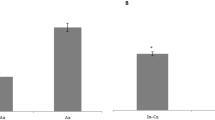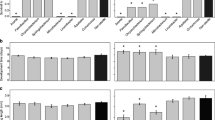Abstract
Life history components, especially those of the adult stage, were investigated in Aedes aegypti and Culex quinquefasciatus in the laboratory. Males of Cx. quinquefasciatus had a greater expectation of life at adult eclosion than males of Ae. aegypti. There was no statistically significant difference in the means of life expectancy for females of Ae. aegypti versus those of Cx. quinquefasciatus. In both species, males had a shorter life than females. The two species exhibited considerable heterogeneity for reproductive characters. Females reproducing for the first time were younger in Cx. quinquefasciatus than in Ae. aegypti. Net reproductive rate and the per capita rate of increase were greater in the former than in the latter species. Cx. quinquefasciatus had a shorter generation time than Ae. aegypti. The data reported here are inconsistent to varying degrees when compared with data gathered by other workers from the same species. The results are discussed with reference to the theoretical constructs of the life history theory.
Résumé
Les phases de l’histoire de la vie, spécialement cells du stade actulté, étaient analysées au laboratoire chez Aedes aegypti et Culex quinquefasciatus. Les mâles de C. quinquefasciatus avaient une ésperance de vie plus élevée lors de l’éclosion à l’etat adulte que les mâles de A. aegypti. Il n’y avait pas de différence statistique significative dans les moyennes de espérances de vie pour les femelles de A. aegypti comparés à ceux de C. quinquefasciatus. Chez les 2 espèces, les mâles avaient une vie plus courte que celle des femelles. Les deux espèces montraient une hétérogénéité considerable dans leurs charactères reproductifs. Les femelles se reproduisant pour la première fois étaient plus jeunes chez C. quinquefasciatus que chez A. aegypti. Le taux de reproduction net et le taux de croissance par tête étaient plus grands chez ceux-ci que chez de génération plus courte que celle de A. aegypti. Les valeurs rapportées ici sont inconsistantes à degrés divers compareés à celles collecteés pa d’autres chercheurs à partir des mêmes éspeces. Les résultats sont discutés en se référant aux considérations théorigues de l’étude des phases de la vie.
Similar content being viewed by others
References
Barbosa P. and Peters T. M. (1973) Some effects of overcrowding on the respiration of larval Aedes aegypti. Entomologia exp. appl. 16, 146–156.
Christophers S. R. (1960) Aedes aegypti L: The Yellow Fever Mosquito, its Life, History, Bionomics and Structure. Cambridge University Press.
Craig G. B. (1967) Mosquitoes: female monogamy produced by male accessory gland substance. Science 156, 1499–1501.
Crovello T. J. and Hacker C. S. (1972) Evolutionary strategies in life table characteristics among feral and urban strains of Aedes aegypti (L.). Evolution 26, 185–196.
Dobshansky T., Lewontin R. and Pavlovsky O. (1964) The capacity for increase in chromosomally polymorphic and monomorphic populations of Drosophila pseudoobsura. Heredity 19, 597–614.
Fish D. and Carpenter S. R. (1982) Leaf litter and larval mosquito dynamics in tree-hole ecosystems. Ecology 63, 283–288.
Gadgil M. and Bossert W. H. (1970) Life historical consequences of natural selection. Am. Nat. 104, 1–24.
Gillet J. D. (1971) Mosquitoes. Weidenfeld & Nicolson, London.
Gomez C, Robinovich J. E. and Machado-Allison C. E. (1977) Population analysis of Culex pipiens fatigans Wied. (Diptera, Culicidae) under laboratory conditions. J. med. Ent. 13, 453–463.
Goodman L. A. (1967) On the reconciliation of mathematical theories of population growth. J. R. statist. Soc. A 130, 541–553.
Ikeshoji T. and Mulla M. S. (1970a) Overcrowding factors of mosquito larvae. J. econ. Ent. 63, 90–96.
Ikeshoji T. and Mulla M. S. (1970b) Overcrowding factors of mosquito larvae. 2. Growth-retarding and bacteriostatic effects of overcrowding factors of mosquito larvae. J. econ. Ent. 63, 1737–1743.
Leslie P. H. (1966) The intrinsic rate of increase and overlap of successive generations in a population of guillemots (Uria alge Pont.). J. Anim. Ecol. 35, 291–301.
Lewontin R. C. (1979) Fitness, survival and optimality. In Analysis of Ecological Systems (Edited by Horn D. J., Stairs G. R. and Mitchel R. D.). Ohio State University Press, Columbia, Ohio.
MacArthur R. H. and Wilson E. G. (1967) The Theory of Island Biogeography. Princeton University, Princeton.
Moore C. G. and Whetacre D. M. (1972) Competition in mosquitoes 2. Production of Aedes aegypti larval growth retardant at various densities and nutrition levels. Ann. ent. Soc. Am. 65, 915–918.
Pianka E. R. (1970) On r- and K-selection. Am. Nat. 104, 592–597.
Reisen W. K. (1975) Intraspecific competition in Anopheles stephensi Liston. Mosquito News 35, 473-182.
Schlosser I. J. and Buffington J. D. (1977) The energetics of r- vs AT-selection in two African strains of Aedes aegypti. Ann. ent. Soc. Am. 10, 196–202.
Southwood T. R. E., Murdie G., Yasud M., Tonn R. J. and Reader P. M. (1972) Studies on the life budget of Aedes aegypti in Wat Samphaya, Bangkok, Thailand. Bull. Wld Hlth Org. 46, 211–216.
Subra R. (1981) Biology and control of Culex pipiens quinquefasciatus Say 1823. Insect Sci. Applic. 1, 319–338.
Trivers R. L. (1972) Parental investment and sexual selection. In Sexual Selection and the Descent of Man 1871–1971 (Edited by Campbell B.). Aldine, Chicago.
Walter N. M. and Hacker C. S. (1974) Variation in life table characteristics among strains of Culex pipiens quinquefasciatus. J. med. Ent. 11, 541–550.
Author information
Authors and Affiliations
Rights and permissions
About this article
Cite this article
Kasule, F.K. A Comparison of the Life History Components of Aedes Aegypti (L.) and Culex Quinquefasciatus Say (Diptera: Culicidae). Int J Trop Insect Sci 7, 143–147 (1986). https://doi.org/10.1017/S1742758400008870
Received:
Revised:
Published:
Issue Date:
DOI: https://doi.org/10.1017/S1742758400008870




